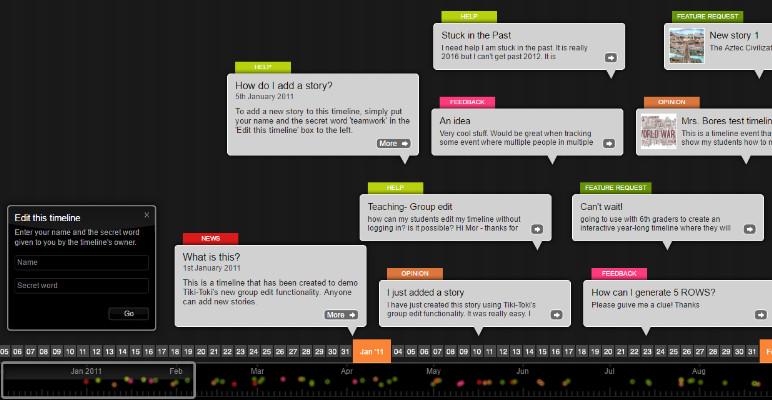PRESENTING INFORMATION USING TIMELINE
1.
DEFINITION OF TIMELINE

A timeline is the presentation of a chronological sequence of
events along a drawn line that enables a viewer to understand temporal
relationships quickly. The term is also sometimes extended to mean a chronology
that is tabular, year-by-year paragraphs or purely conceptual. Increasingly,
timelines are illustrated in infographics combining text and
graphic images for a better presentation.
Timelines are useful to document any type of development,
providing an easy-to-understand history and helping viewers to understand past
and ongoing trends. The tools are also useful
for management tasks. In project management, for example, a
timeline illustrates milestones, deadlines and other significant
dates and events over the lifecycle of the project, clearly tying goals to
specific dates. Annotations to the timeline can document actual progress.
2. HOW TO USE TIMELINE TO SUPPORT TEACHING
It can help students
keep events in chronological order as they write summaries. But most important
of all, they can also provide comprehension support to English language
learners (ELLs), helping them make connections and recognize patterns in a
series of process. Because numerical markers such as hours, years, days or
months are placed apart with plenty of space in between, timelines can appear
visually less complex than pure text, helping ELLs more easily relate events to
their corresponding times. Both educators and parents can use timelines to help
students organize information in a chronological sequence so that they can
better understand growth, change, recurring events, cause and effect, and key
events of historical, social, and scientific significance (Moline, 1995).
Suggested Activities
Early Elementary
Grades (K-2)
·
Timelines can be
introduced to help ELLs understand chronological events while they are gaining
English vocabulary to expand their oral and written skills.
·
Students can create
simple timelines in which they describe a day in their life, or they can
describe what happened in a story they just heard or read.
·
Younger children
might use visual images or drawings to represent events.
Elementary & Later Grades (3-12)
·
Timelines can be
used at these grade levels to ensure that students have an in-depth
understanding of chronological events in social studies, science and language
arts.
·
At this level,
timelines can represent more complex ideas. They should include complete
sentences, with detailed information for each event.
3. THE KINDS OF TOOLS TO MAKE TIMELINE
See a brief history of CALL in this timeline:
https://www.tiki-toki/timeline/entry/1208655/project-CALL/
(I have been submitted this link on Assignment folder of Session 4 on March 12, 2019. You can check on Schoology. The link can be viewed using a laptop on that day when I submitted, but now I can open the link only using handphone Sir. I do not know what's the problem, Sir, Forgive me. I suggest you open the link via phone)
(I have been submitted this link on Assignment folder of Session 4 on March 12, 2019. You can check on Schoology. The link can be viewed using a laptop on that day when I submitted, but now I can open the link only using handphone Sir. I do not know what's the problem, Sir, Forgive me. I suggest you open the link via phone)
This is the evidence of Screenshot from my phone


 Facebook
Facebook Twitter
Twitter Google+
Google+ Rss Feed
Rss Feed
0 komentar: